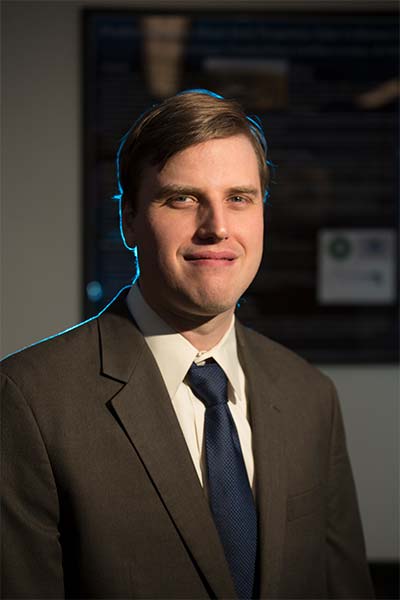The time to pop the champagne had finally arrived. Applause, whoops and a serenade of “chirps” erupted inside Cal State Fullerton’s Gravitational-Wave Physics and Astronomy Center on this early February 2016 morning. The first direct detection of gravitational waves — ripples in the fabric of space-time — had just been announced to the world, opening a new window onto the cosmos. An international collaboration of scientists, including researchers from Cal State Fullerton, heard the distinctive “chirp” — a pair of black holes colliding over 1 billion years ago in the distant universe that produced the gravitational waves. The observation of the black-hole merger also confirmed a major prediction Albert Einstein made 100 years ago in his general theory of relativity: gravitational waves exist.
As key contributors in the discovery, Titan researchers and their students gathered inside the gravitational-wave research center in McCarthy Hall to witness the announcement by the National Science Foundation and international Laser Interferometer Gravitational-Wave Observatory (LIGO) Scientific Collaboration. After LIGO scientists proclaimed, “We did it!” at the news conference in Washington, D.C., the Titans cheered with their colleagues across the globe.
Leading the CSUF research team is Joshua Smith, associate professor of physics, with Jocelyn Read and Geoffrey Lovelace, both assistant professors of physics, and Alfonso Agnew ’94 (B.A. math, B.S. physics), professor of mathematics. Read and Smith are leaders in the LIGO Scientific Collaboration working groups that searched for and validated the gravitational-wave signal.
The LIGO Scientific Collaboration involves more than 1,000 scientists from universities around the United States and in 14 other countries, including CSUF. Additionally, more than 40 CSUF undergraduates and master’s-level students have worked on this groundbreaking research and shared in the discovery.
Cal State Fullerton’s significant contributions focused on different aspects of LIGO gravitational-wave research. Smith’s work centered on identifying and removing sources of noise in the Advanced LIGO instruments to improve the quality of the data in searching for gravitational waves. Read, an astrophysicist, explored how neutron stars can produce gravitational waves. Lovelace, a computational relativist, created computer simulations and visualizations to better predict the sources of gravitational waves, such as colliding black holes or a black hole tearing apart a neutron star. Agnew has developed mathematical methods to find and study cosmological solutions to Einstein’s equations in the past, and is currently working toward building and studying models of objects that emit the gravitational-wave signals.
Faculty members also have received more than $2 million in funding from the National Science Foundation and the Research Corporation for Science Advancement for their research.
“In all of human existence, people have been mystified by the skies. Nearly everything we’ve learned about astronomy, we’ve learned from light waves,” says Smith, Dan Black Director of the Gravitational-Wave Physics and Astronomy Center. “What I’m most excited about with this first gravitational-wave detection, is it opens up a new field of astronomy, where scientists use gravity to see astronomical objects like black holes, neutron stars and supernova explosions. What we’ll learn will have long-term benefits to society that are impossible to predict.”




